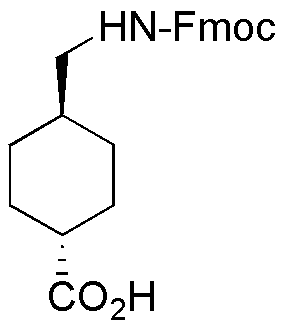Fmoc-tranexamic acid is widely utilized in research focused on:
- Peptide Synthesis: It serves as a protective group in the synthesis of peptides, allowing for the selective modification of amino acids without interfering with other functional groups.
- Drug Development: This compound is explored in the development of new pharmaceuticals, particularly in the formulation of drugs that require specific delivery mechanisms.
- Bioconjugation: Fmoc-tranexamic acid is used in bioconjugation processes, enabling the attachment of biomolecules to surfaces or other molecules, which is crucial in creating targeted therapies.
- Diagnostics: It plays a role in the development of diagnostic tools, particularly in assays that require precise interactions between biomolecules.
- Research in Cancer Treatment: The compound is investigated for its potential applications in cancer therapies, particularly in enhancing the efficacy of existing treatments by modifying drug properties.
General Information
Properties
Safety and Regulations
Applications
Fmoc-tranexamic acid is widely utilized in research focused on:
- Peptide Synthesis: It serves as a protective group in the synthesis of peptides, allowing for the selective modification of amino acids without interfering with other functional groups.
- Drug Development: This compound is explored in the development of new pharmaceuticals, particularly in the formulation of drugs that require specific delivery mechanisms.
- Bioconjugation: Fmoc-tranexamic acid is used in bioconjugation processes, enabling the attachment of biomolecules to surfaces or other molecules, which is crucial in creating targeted therapies.
- Diagnostics: It plays a role in the development of diagnostic tools, particularly in assays that require precise interactions between biomolecules.
- Research in Cancer Treatment: The compound is investigated for its potential applications in cancer therapies, particularly in enhancing the efficacy of existing treatments by modifying drug properties.
Documents
Safety Data Sheets (SDS)
The SDS provides comprehensive safety information on handling, storage, and disposal of the product.
Product Specification (PS)
The PS provides a comprehensive breakdown of the product’s properties, including chemical composition, physical state, purity, and storage requirements. It also details acceptable quality ranges and the product's intended applications.
Certificates of Analysis (COA)
Search for Certificates of Analysis (COA) by entering the products Lot Number. Lot and Batch Numbers can be found on a product’s label following the words ‘Lot’ or ‘Batch’.
*Catalog Number
*Lot Number
Certificates Of Origin (COO)
This COO confirms the country where the product was manufactured, and also details the materials and components used in it and whether it is derived from natural, synthetic, or other specific sources. This certificate may be required for customs, trade, and regulatory compliance.
*Catalog Number
*Lot Number
Safety Data Sheets (SDS)
The SDS provides comprehensive safety information on handling, storage, and disposal of the product.
DownloadProduct Specification (PS)
The PS provides a comprehensive breakdown of the product’s properties, including chemical composition, physical state, purity, and storage requirements. It also details acceptable quality ranges and the product's intended applications.
DownloadCertificates of Analysis (COA)
Search for Certificates of Analysis (COA) by entering the products Lot Number. Lot and Batch Numbers can be found on a product’s label following the words ‘Lot’ or ‘Batch’.
*Catalog Number
*Lot Number
Certificates Of Origin (COO)
This COO confirms the country where the product was manufactured, and also details the materials and components used in it and whether it is derived from natural, synthetic, or other specific sources. This certificate may be required for customs, trade, and regulatory compliance.


